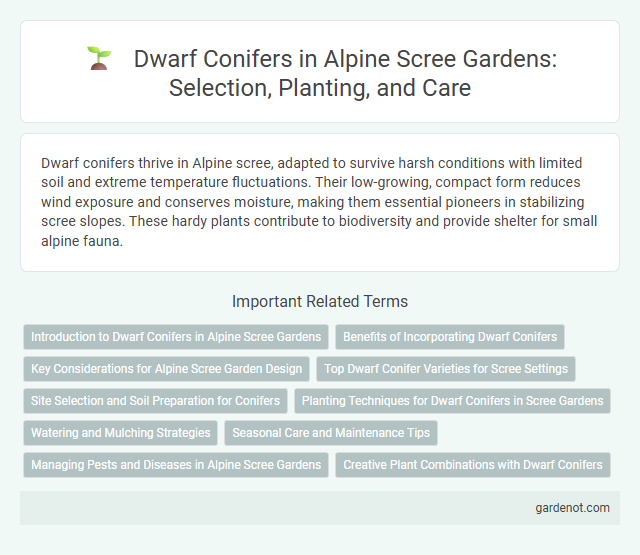Dwarf conifers thrive in Alpine scree, adapted to survive harsh conditions with limited soil and extreme temperature fluctuations. Their low-growing, compact form reduces wind exposure and conserves moisture, making them essential pioneers in stabilizing scree slopes. These hardy plants contribute to biodiversity and provide shelter for small alpine fauna.
Introduction to Dwarf Conifers in Alpine Scree Gardens
Dwarf conifers thrive in Alpine scree gardens due to their compact size and resilience to harsh, rocky environments with poor soil and extreme weather conditions. These miniature evergreens, such as dwarf pines and spruces, provide year-round structure and texture while stabilizing scree slopes against erosion. Their slow growth and hardy nature make them ideal for alpine landscapes where larger trees cannot survive.
Benefits of Incorporating Dwarf Conifers
Dwarf conifers enhance alpine scree gardens by providing year-round greenery and structural diversity, which supports soil stabilization on rocky slopes. Their slow growth and compact size make them ideal for harsh, low-nutrient environments, reducing maintenance while promoting microhabitats for alpine fauna. Incorporating species like dwarf pines and junipers improves biodiversity and visual interest, contributing to ecological balance and erosion control in alpine landscapes.
Key Considerations for Alpine Scree Garden Design
Dwarf conifers in alpine scree garden design require careful selection of species such as Pinus mugo and Juniperus communis for their drought tolerance and compact growth habit. Soil drainage and exposure to full sun are critical factors, as these plants thrive in well-drained, rocky substrates with minimal organic matter. Incorporating dwarf conifers enhances year-round structure and provides habitat for alpine fauna while maintaining the ecological balance of high-altitude scree environments.
Top Dwarf Conifer Varieties for Scree Settings
Dwarf conifers such as Pinus mugo var. pumilio, Picea glauca 'Conica', and Juniperus communis var. depressa excel in alpine scree settings due to their compact growth habit and tolerance to rocky, well-drained soils. These varieties exhibit exceptional drought resistance and cold hardiness, thriving in the nutrient-poor substrate typical of scree slopes. Their dense foliage provides erosion control and adds year-round visual interest to challenging mountain landscapes.
Site Selection and Soil Preparation for Conifers
Dwarf conifers thrive in well-drained, rocky alpine scree environments with full sun exposure and minimal competition from larger vegetation. Site selection should prioritize areas with acidic to neutral pH soils, rich in organic matter yet free from waterlogging to prevent root rot. Soil preparation involves loosening compacted scree and incorporating coarse sand or gravel to enhance drainage and aeration critical for healthy root development.
Planting Techniques for Dwarf Conifers in Scree Gardens
Dwarf conifers thrive in scree gardens when planted with well-draining, mineral-rich soil that mimics their natural alpine environment. Positioning these plants on a slight incline ensures optimal water runoff and prevents root rot. Incorporating coarse gravel or sand around the root zone improves aeration, enhancing root establishment and overall growth in the challenging scree substrate.
Watering and Mulching Strategies
Dwarf conifers in alpine scree thrive with careful watering strategies that emphasize deep, infrequent irrigation to mimic natural precipitation patterns and prevent root rot. Mulching with gravel or small stones enhances moisture retention while improving drainage, critical to replicating the well-drained, mineral-rich substrates of alpine scree habitats. These practices optimize root health and promote resilience in harsh, drought-prone conditions characteristic of high-altitude environments.
Seasonal Care and Maintenance Tips
Dwarf conifers in alpine scree require well-drained soil and minimal watering during dormant winter months to prevent root rot. Pruning should be done in early spring to maintain shape and promote healthy growth, avoiding late-season cuts that can expose the plant to frost damage. Mulching with gravel or small stones helps regulate soil temperature and moisture, mimicking natural alpine conditions.
Managing Pests and Diseases in Alpine Scree Gardens
Dwarf conifers in alpine scree gardens require vigilant monitoring to prevent infestations by common pests such as aphids, spider mites, and scale insects. Effective pest management incorporates natural predators, regular pruning, and the application of organic insecticides to maintain plant health without disrupting the delicate alpine ecosystem. Disease prevention focuses on ensuring proper drainage and airflow to reduce fungal infections like needle cast and root rot, which frequently threaten dwarf conifers in rocky, high-altitude environments.
Creative Plant Combinations with Dwarf Conifers
Dwarf conifers thrive in alpine scree environments due to their compact size, resilience, and slow growth, making them ideal for rock gardens and crevice planting. Combining species such as Pinus mugo pumilio, Juniperus communis nana, and Abies koreana creates dynamic textures and year-round color contrasts that enhance the rugged landscape. These combinations increase biodiversity, improve soil stability, and provide microhabitats for alpine wildlife, adding ecological value to aesthetic appeal.
Dwarf conifer Infographic

 gardenot.com
gardenot.com